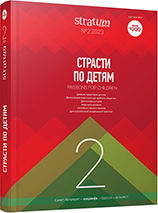Апотропеи в инвентаре древнеегипетских детских погребений I тыс. до н. э. из Восточной Гизы: археологический контекст, типология и интерпретация
Apotropaea in the Equipment of Ancient Egyptian Infant Burials of the 1st Millennium BC from Eastern Giza: Archaeological Context, Typology, and Interpretation
Author(s): Maksim A. Lebedev, Svetlana E. MalykhSubject(s): History, Archaeology, Ancient World
Published by: Издательский дом Stratum, Университет «Высшая антропологическая школа»
Keywords: Ancient Egypt; Third Intermediate Period; Giza necropolis; burial rites; infant burials; apotropaic amulets;
Summary/Abstract: The paper analyzes the results of the work of the Russian Archaeological Mission of the Institute of Oriental Studies of the Russian Academy of Sciences at Giza in 2013, 2017, and 2019—2020. During these seasons, the team recorded a unique double infant burial in an amphora in rock-cut tomb GE 49 (the southern section of the Russian concession) and a cemetery to the west of the rock-cut tomb of Kakherptah (the north-western section of the Russian concession). The internments are dated to the first half of the 1st millennium B. C. The infant burial in an Egyptian amphora of Dynasty XXI (1070/1069—946/945 B. C.) has been preserved in fragments. However, part of the accompanying inventory has survived and is represented by a beaded bracelet and a scarab amulet. Of the 29 burials in the cemetery near the tomb of Kakherptah, 11 belonged to children. They are mostly well preserved, allowing us to study the features of burial rites, which included inhumation in an extended position on the back, head to the west with some shift to the south or north. The latter is probably related to burial at different months when orientation of internments followed the solar declination. Unlike the burials of adults, which remained without grave goods, the infant burials were equipped with a significant amount of jewelry and apotropaic amulets. Their shape is typical for Dynasties XXII—XXV (946/945—664 B. C.), which determines the dating of the cemetery near the tomb of Kakherptah. Despite the abundance of comparative material, primarily amulets, in Egyptological literature and museum collections, the discovery of these items in situ is extremely rare. The archaeological context allows us to consider the characteristics of their use in the ancient Egyptian burial rites of the Third Intermediate Period.
Journal: Stratum plus. Археология и культурная антропология
- Issue Year: 2023
- Issue No: 2
- Page Range: 81-104
- Page Count: 24
- Language: Russian
- Content File-PDF

